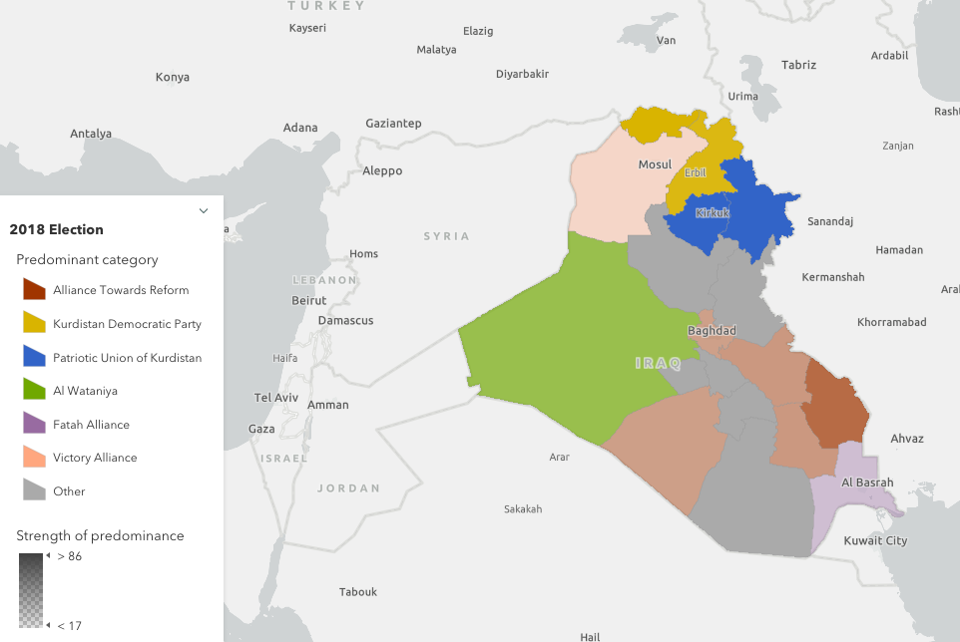Mapping Iraq’s electoral evolution

A map of how Iraq's election districts voted in 2018, created by PhD student Houman Oliaei
On October 10, 2021, Iraqis will participate in the sixth parliamentary election since the U.S.-led invasion that toppled Saddam Hussein in 2003. In advance of the election, Houman Oliaei, a PhD student in anthropology, has been creating a story map to collect scattered data on Iraqi elections and present them in a coherent and accessible way. In September, he spoke with BrandeisNow about his project.
Can you tell us about yourself?
I’m originally from Iran. I attended the University of Tehran, where I earned a BA in Iranian Classical Music and an MA in Cultural Anthropology. I came to Brandeis to pursue my PhD in sociocultural anthropology in 2015. I am a qualitative researcher and GIS Specialist and am studying the lived experiences of Yezidis, an ethno-religious minority in northern Iraq that experienced genocidal violence and forced displacement following an ISIS attack on the Sinjar region in August 2014. I spent almost a year in Iraq, doing fieldwork among displaced Yezidis in a refugee camp in Iraqi Kurdistan, studying everyday experiences of displaced Yezidis who struggle to gain cultural and legal recognition within the humanitarian and state network.

Houman Oliaei
I focus on their lived experiences, and how they struggle to make their lives livable and get the resources they need.
How did the idea for this project originate?
I came up with the idea of a story map of Iraqi elections while working on one of my dissertation chapters. I was trying to look at the election results of local and general elections in Iraq to understand how minority groups are represented in the elections. I realized that the data we have about Iraqi parliamentary elections are very scattered, and sometimes difficult to comprehend, and I couldn’t find a source that could summarize the last 16 years of parliamentary elections and the voting trends. In some cases, the data was available but didn’t have enough graphic representation. The data might be accessible and comprehensible for Iraqi analysts, but not for the people who are not closely monitoring or analyzing Iraqi politics over the last 16 years. I collected the data for the story map from different sources, from policy papers to news reports, in both Arabic and English, in order to make them accessible in one place.
When we think about the United States elections, there are many visualisations, analyses, and raw data that span a long period of time. But when it comes to a country like Iraq, this data is not easily accessible for those who might be interested in learning more about Iraqi elections and politics. The story map, which contains interactive content, gives a broad view of the 16 years of parliamentary elections in Iraq, the transformations of main political coalitions, the outcome of the elections, the turnouts, as well as the breakdown of seats won by each party. It visualizes and traces the different electoral systems as well as political coalitions over the last 16 years.
Why is this important today?
This data is very important because we’re having an early election in October in Iraq. It is taking place in the backdrop of a protest movement that started in 2019, and some argue that it is the largest grassroots socio-political mobilization in Iraq's modern history. The early election was scheduled to address the demands of the protestors. One of the demands of this anti-corruption movement was to end the sectarian political system that has been institutionalized and infiltrated Iraqi politics since the 2003 American invasion. So I thought it would be interesting to visualize previous Iraqi elections, to see if the 2021 election will bring any change.
The Iraqi government implemented some electoral reforms to address the grievances of the protesters. For instance, in the past election, people could only choose from an open or closed party list, but for this election, they can also vote for independent candidates. Additionally, instead of designating each governorate as a single district, the new law divides the country's provinces into smaller districts, which can benefit independent candidates. It will be interesting to see if these changes will diversify the Iraqi political field and give room to independent candidates who might have a better chance of winning at the district level rather than the provincial level.
Another important thing about the upcoming election is the turnout. As I said, the early election is the result of a massive protest movement in Iraq, so some analysts expect that participation in the election to be a record low (one of the polls predicted only 29 percent participation). However, there have been some calls from influential figures in Iraq to encourage people to participate in the election. For instance, Iraq’s top Shiite cleric Grand Ayatollah Ali Al Sistani on Wednesday called on the public to head to the polls on October 10 and vote for a new government. So it will be interesting to see the turnouts of the election, given the street protest and corruption. The turnout is important in this election because a low turnout due to the boycott can lead to the victory of established parties, and perhaps the repetition of the negotiations along sectarian lines. On the other hand, a high turnout can empower independent candidates to have a more active role in the formation of the next government.
I hope to develop this story map in the future to include the local elections, and profiles of some of the independent politicians as well. I think that the story map about Iraqi elections is going to be beneficial both for professionals who are analyzing Iraq, as well as for the public audience to have a sense of what’s happening in Iraq.
Categories: Humanities and Social Sciences, Research





